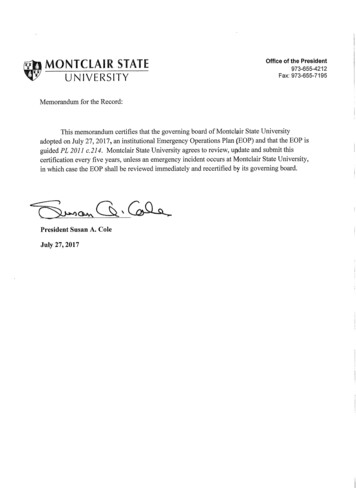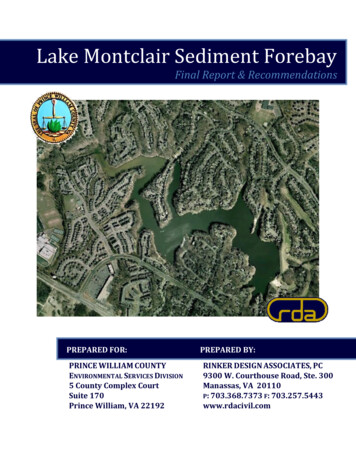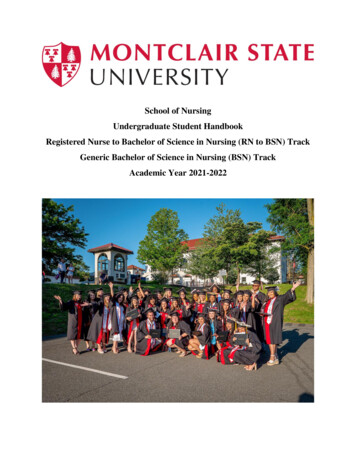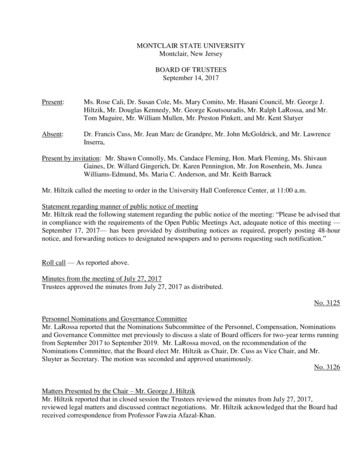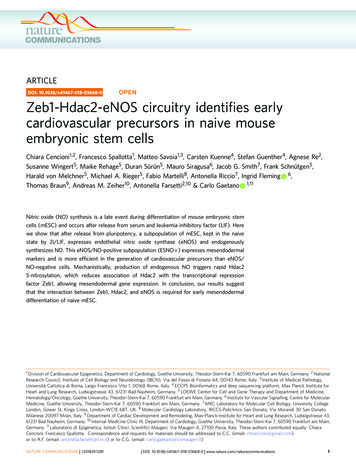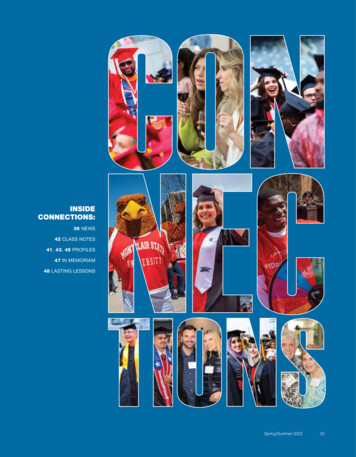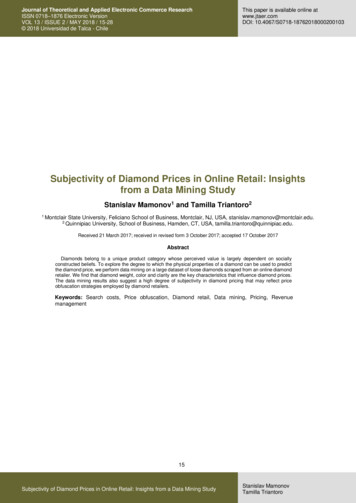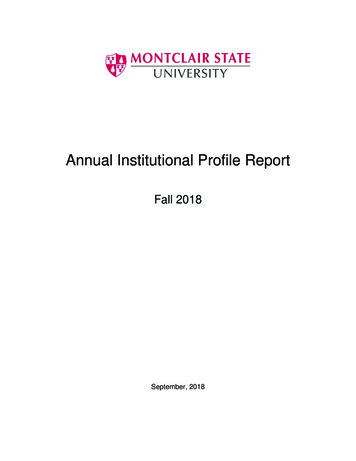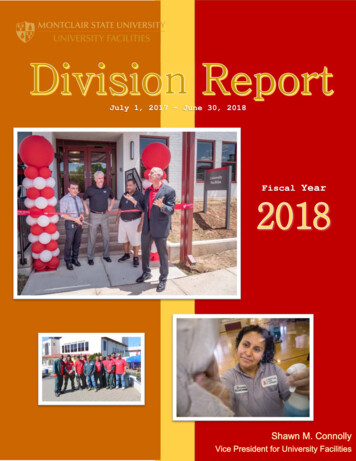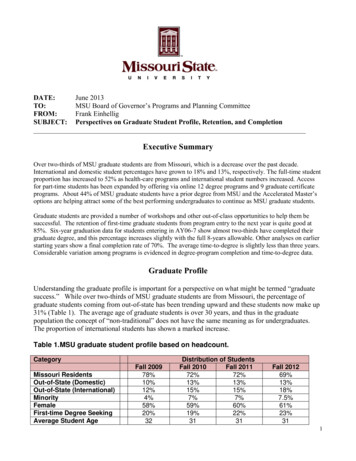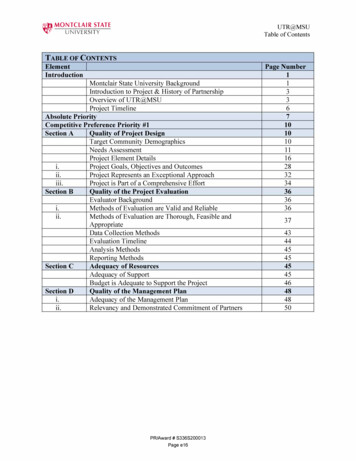
Transcription
(yt) MONTCLAIR STATEWUTR@MSUTable of ContentsUNIVERSITYTABLE OF CONTENTSElementIntroductionMontclair State University BackgroundIntroduction to Project & History ofPartnershipOverview ofUTR@MSUProject TimelineAbsolute PriorityCompetitive Preference Priority #1Section AQuality of Project DesignTarget Community DemographicsNeeds AssessmentProject Element Details1.Project Goals, Objectives and Outcomes11.Project Represents an Exceptional Approach.lll.Project is Part ofa Comprehensive EffortSection BQuality of the Project EvaluationEvaluator Background1.Methods ofEvaluation are Valid and Reliable11.Methods ofEvaluation are Thorough, Feasible andAppropriateData Collection MethodsEvaluation TimelineAnalysis MethodsReporting MethodsAdequacy of ResourcesSection CAdequacy ofSupportBudget is Adequate to Support the ProjectSection DQuality of the Mana2ement Plan1.Adequacy ofthe Management Plan11.Relevancy and Demonstrated Commitment ofPartnersPR/Award # S336S200013Page e16Pa2e 484850
(yt) MONTCLAIR STATEWIUTR@MSUProject NarrativeUNIVERSITYINTRODUCTIONMontclair State University Background: Montclair State University (MSU), designatedHispanic Serving Institution (HSI) of higher education, was founded in 1908. Today we are thesecond largest public university in New Jersey. Located approximately 18 miles from New YorkCity MSU enrolled 16,687 undergraduate and 4,320 graduate students in Fall 2019. We offer 66undergraduate majors, 47 master's programs, and seven doctoral programs, including an Ed.D.program in Teacher Education and Teacher Development.MSU was the first university in the nation to create a Center of Pedagogy (CoP), in whichfaculty and the public schools are equal partners in the ongoing work of teacher education. Citedby the U.S. Department of Education as a best practice, CoP coordinates all aspects of teachereducation, including the establishment of teacher education policies and practices. MSU alsoestablished the MSU Network for Educational Renewal (MSUNER) as the vehicle for MSU'spartnership with 30 New Jersey school districts, including our two partner local educationagencies (LEAs) in this proposal - Newark Board of Education (NBOE) and Orange PublicSchools (OPS), and over 13,000 professional educators. As one of the foremost school-universitypartnerships in the nation, MSUNER partners MSU faculty and staff with school district facultyand administrators delivering professional development, creating opportunities for MSU LEAcollaborations, and the opportunity to interact with national experts on school and teachereducation reform. Over the past 15 years, the MSUNER has developed an extensive professionaldevelopment program that is grounded in a research-based conception of the essentialcharacteristics of professional development and focused on topics relevant to our partners.MSU's education programs - especially its teacher education program - are nationallyrecognized for quality, innovation and impact, as evidenced briefly by the awards listed below:Page 11PR/Award # S336S200013Page e17
(yt) MONTCLAIR STATEWUTR@MSUProject NarrativeUNIVERSITY Cited as one of 15 leading educator preparation programs launching the EducatorPreparation Laboratory (EdPrepLab), created by the Learning Policy Institute. Serving onEdPrepLab's Steering Committee, 2019 Winner of the Michelli Award for Promoting Social Justice in Teacher Education toensure equity and social justice in our schools and our democracy by the NationalNetwork for Education Renewal, 2016 Winner of the Richard W. Clark Award for Exemplary Partner School Work, NationalNetwork for Educational Renewal, 2005, 2009, 2016 Identified as one of seven programs across the U.S. that are exemplary in preparingteachers to teach for deeper learning and equity by the Learning Policy Institute, 2015 Featured as an exemplary practice by Teachers for a New Era Learning Network, 2013 Received two Robert Noyce Teacher Scholarship grants from the National ScienceFoundation in 2014 to: 1) Implement a major in mathematics with elementary teachercertification; and 2) Recruit and support 30 new teachers Cited by the American Association of Colleges for Teacher Education (AACTE) for thehigh-quality of clinical experiences and collaboration with NBOE, 2013 Received the Certificate of Excellence in Teacher Education from New Jersey Office ofHigher Education, 2011 Cited as exemplary models of clinical practice, school district partnerships, and theability of graduates to have a positive impact on their students by the Academy forEducational Development, National Institute for Work and Learning, 2011As documented by our most recent Title II filing with the Department of Education (seeAppendix H-1) for the last three years 98 to 100% of program completers pass all of theapplicable New Jersey state qualification assessments for teachers. Further, all of the candidatesPage 12PR/Award # S336S200013Page e18
(yt) MONTCLAIR STATEWUTR@MSUProject NarrativeUNIVERSITYwho are accepted into our teacher residency programs will have passed both entrancestandardized examinations (Praxis I Core and the ACT or SAT, meeting the cut-off score as wellas the exit standard exam (Praxis 11) subject examination.Introduction to Project & History of Partnership: MSU has worked collaboratively withNBOE for more than IO years implementing a variety of programs, including two TeacherQuality Partnership programs. Our partnership with OPS is more recent (approximately fiveyears). To date we have implemented the Woodrow Wilson Teaching Fellowship Program, aresidency program for secondary science and mathematics teachers, and have converted twolow-performing schools into University-Assisted Full-Service Community Schools.Overview of UTR@MSU: With this proposal, UTR@MSU, we continue our partnership withNBOE, and expand our Urban Teacher Residency (UTR) model to an additional school district(OPS) to determine the replicability and potential to scale. We build on our history of operatingsuccessful teacher residency programs that drastically change the typical trial-by-fire nature ofthe transition from pre-service to novice teacher. Owing to the amount and quality of classroomexperience and mentoring the teaching residents will receive, teachers completing our teacherresidency programs enter their first classroom with a solid repertoire of pedagogical practicesand a good understanding of how those practices can be successfully applied. Participantscompleting the program bring contextualized knowledge of the district that comes from beingimmersed in schools and working directly in a clinical apprenticeship with expert, experiencedteachers. Professional development combined with three-years of induction support provideseach participant with the classroom and leadership skills our partner districts desire.With the new iteration of our program, the UTR@MSU program, MSU, NBOE and OPS willensure that novice teachers completing the program have a deep grounding in what it means tobe a highly effective teacher. Our stringent evaluation will provide the opportunity for MSU andPage 13PR/Award # S336S200013Page e19
(yt) MONTCLAIR STATEWUTR@MSUProject NarrativeUNIVERSITYour partners to assess what works, what program elements are highly replicable and scalable, andwill serve as a model to guide the preparation of teachers for urban schools beyond our twopartners. Owing to our partnership with the Education Preparation Laboratory (EdPrepLab) andthe Urban Teacher Education Consortium (UTEC), we will be able to broadly disseminate whatwe learn and influence teacher residency programs.UTR@MSU encompasses each characteristic of a successful teacher residency program asdiscussed in the section labeled Absolute Priority (see page 7). A yearly timeline of essentialelements of our project is provided in Table I (see page 6). Our timeline, in brief, demonstratesthat in Year 1 we will engage in active planning for the project implementation with NBOE andOPS, securing Memoranda of Understanding with each. We will develop our project advisorycouncil consisting of MSU, NBOE, and OPS personnel. We will also begin the efforts to recruithighly qualified individuals into the teacher residency program with the support of the WoodrowWilson Foundation Teaching Fellowship Program, focusing on traditionally underrepresentedminority groups (UR Gs) that are highly desired by both districts.Our first cohort of at least 12 teacher residency candidates from NBOE will enroll in theprogram in June. In Year 2 we will enroll a second cohort consisting of at least 12 teacherresidency candidates from NBOE and at least four candidates from OPS for a total of 16 teacherresidency candidates. Staggering the enrollment provides us with an opportunity to work with,and prepare OPS for the program, and provides them with an opportunity to observe prior toimplementation. Our cohorts represent the desired level of participation from each district and isconsistent with the financial resources each is able to pledge.Across the five years, we will enroll four cohorts, totaling at least 60 individuals (48 withNBOE and 12 with OPS). The timing of activities from recruitment through entry in the master'sprogram (MAT) including teacher residents obtaining certification and becoming the teacher ofPage 14PR/Award # S336S200013Page e20
(yt) MONTCLAIR STATEWUTR@MSUProject NarrativeUNIVERSITYrecord will be the same for each subsequent cohort. Individuals in each cohort will receive a 12month stipend that is paid for in-part by our District partners. Teacher residency candidates willobtain their teaching certificate prior to completing their 18-month master's program and will,upon receipt of their teaching certificate, become the teacher of record in one of the districts.Mentoring and induction are essential elements of our program. We will work diligently withboth NBOE and OPS to identify and select mentors for our teacher residency candidates.Mentors will support candidates throughout their participation in the program, including theirperiod of a guided teaching apprenticeship. Mentors will be carefully selected based on a varietyof criteria (see page 18). Mentors will receive professional development that will support andguide their mentoring efforts. Following their apprenticeship period, the teacher resident willreceive additional support in the form of a three-year induction program implemented by theirdistrict with support from MSU. Our five-year budget reflects these costs.Induction services are provided at no-cost to this project as it is an existing service currentlyprovided by MSU that will be transferred to become the responsibility of our district partnersbeginning in Year 2 (NBOE) and 3 (OPS). MSU will continue to provide the professionaldevelopment for the mentors and teachers in areas requested by each district throughout theproject. Topics for the planned professional development include diversity, equity, and inclusion,as well as social emotional learning, cognitive coaching, universal design for learning, datadriven assessment, and action research.Essential elements of our program are summarized in our timeline, provided as Table I onthe following page. A key to the abbreviations is as follows: N Newark Board of Education; 0 Orange Public Schools; n Cohort 1; nB Cohort Begins; nS Stipend Begins nE CohortEnds; nN Stipend Ends; TCa Teacher Cert. Obtained; TRa Participant becomes Teacher ofRecord.Page 15PR/Award # S336S200013Page e21
(yt) MONTCLAIR STATEWUTR@MSU.Pro1ect Narraf1veUNIVERSITYTABLE 1: SAMPLE TIMELINE FOR UTR@MSU (18 MONTH DEGREE PROGRAM)Year OneActivityQuarter 1Quarter 2Quarter 3DJFM AMNNNNNNNNN N00000000001122222MAMPlanningN NN NNNN&MOUs0 00 0001IIMATCert. Prep&Record1JJQuarter Is0 NDNNNN NN00000 00222333II111IE/2ITCs22 22II11111I22222 22II1II1II1IISIIIIIIIIIIIII1II1II1I111IIIII11 1IQuarter 4AlBMentoringMentorPDQuarter 3NFIQuarter 20J1Quarter 1sDand EnrollQuarter 4A0 NRecruitYeara3Year2JJ121ITR2TeacherIBRes. PDInduct.IProgramIIIIPage 16PR/Award # S336S200013Page e22
(yt) MONTCLAIR STATEWIUTR@MSUProject NarrativeUNIVERSITYABSOLUTE PRIORITYOur proposal addresses the Absolute Priority: Partnership Grants for the Establishment ofEffective Teaching Residency Programs. Specifically, we propose an effective residencyprogram that will prepare prospective and novice teachers with strong teaching skills. Weinclude each of the following required activities encompassed in the Absolute Priority, below:a) Supporting a teaching residency program for high-need subjects and areas as determinedby the two local education agencies (LEAs) in our partnership. We will work with two high-needs school districts, specifically NBOE and OPS, tooperate a teacher residency program. Consistent with the desires of the two LEAs, theprogram will work to recruit applicants from URGs to the program, and will provideteacher residents with the education, training, and skills necessary to work in the twodistricts, teaching in high-needs schools in high-need subject areas.b) Placing graduates of the teaching residency program in cohorts that facilitate professionalcollaboration. Our program will support 60 teacher residents in four cohorts across the five-yearprogram. Teacher residents will obtain their teaching certification within 12 months ofenrollment, becoming a teacher of record at a school within NBOE or OPS, obtain theirmaster's degree within 18 months of enrollment, and participate in both mentoring andinduction programming supported by professional development.c) Support through an induction program. Our induction program, operated in collaboration with NBOE and OPS, provides three years of induction support and professional development.d) Ensuring that teaching residents who participate in the teaching residency programPage 17PR/Award # S336S200013Page e23
(yt) MONTCLAIR STATEWUTR@MSUProject NarrativeUNIVERSITYreceive: 1) Effective pre-service preparation; 2) Teacher mentoring; 3) Support through aninduction program as teaching residents enter the classroom as new teachers; and 4) Incorporateclinical learning in classrooms in high-need schools in partnership with the LEA; b) Supervisedinteraction with the school district; Integrating pedagogy and classroom practice and promotingeffective teaching skills; and providing high-quality teacher mentoring. Our program encompasses each of these elements as discussed in Section A (page A).Our program is built on a partnership of more than three decades between NBOE andMontclair State University (MSU) and our newer partnership with OPS. Our partnership withboth LEAs is dedicated to preparing quality teachers. With this proposal, we will: (a) increaseopportunities for high-quality preparation of and professional development for teachers and (b)increase the numbers of individuals from groups URGs teaching in both school districts.Additional elements of our program that are aligned with the Required TQP AbsolutePriority Checklist are outlined below:1. We integrate pedagogy, classroom practice, and teacher mentoring.2. We engage teaching residents in rigorous graduate-level coursework leading to a master'sdegree within 18-months while undertaking a guided teaching apprenticeship.3. We provide experience and learning opportunities for teacher residents alongside atrained and experienced mentor teacher and: Ensure teaching complements the residency program so that classroom clinical practice istightly aligned with coursework; Train mentors to serve as a teacher leader of the teaching residency program, as a mentorfor residents; Create a learning community in which all individuals are expected to continually improvePage 18PR/Award # S336S200013Page e24
(yt) MONTCLAIR STATEWUTR@MSUProject NarrativeUNIVERSITYtheir capacity to advance student learning; and Work with our school district partners to ensure resident mentors and induction mentorshave the necessary time to devote to their mentees and inductees.4. We have established clear criteria for the selection of mentor teachers based on measuresof teacher effectiveness and the appropriate subject area knowledge. Evaluation of teachereffectiveness is based on, but not limited to, observations of the following Planning and preparation, including demonstrated knowledge of content, pedagogy, andassessment, the use of formative and diagnostic assessments to improve student learning. Appropriate instruction that engages students with different learning styles. Collaboration with colleagues to improve instruction. Analysis of gains in student learning, based on multiple measures that are valid andreliable and that, when feasible, may include valid, reliable, and objective measures ofthe influence of teachers on the rate of student academic progress.5. We group teaching residents in cohorts to facilitate professional collaboration. We have developed admissions goals and priorities: a) That are aligned with the hiringobjectives, instructional initiatives, and curriculum of NBOE and OPS, in exchange fortheir commitment to hire qualified graduates from the teaching residency program; and b)That reflect the priorities of both NBOE and OPS to hire applicants who reflect thecommunities in which they will teach and give consideration to underrepresentedpopulations in the teaching profession.6. We provide support for resident graduates, once they are hired as teachers of record,through an induction program, professional development, and networking opportunities tosupport the residents through the residents' first three years of teaching.Page 19PR/Award # S336S200013Page e25
(yt) MONTCLAIR STATEWUTR@MSUProject NarrativeUNIVERSITYEach element of our program is discussed further in Section A, Quality of Project Design,beginning later on this page.ICOMPETITIVE PREFERENCE PRIORITY #1:Within Essex County, New Jersey, home to both of our LEA partners, there are 23 censustracts that are designated Qualified Opportunity Zones (QOZs). Two in particular are the focusof our application include: Census Tract 34013008100 in NBOE, and Census Tract34013018900 in OPS. Services will be provided to the district and schools in these zones.Teacher residency candidates will be placed into programming that will serve the schools andstudents who live in these zones.ISECTION A: QUALITY OF PROJECT DESIGNTarget Community Demographics: As introduced previously, MSU is proposing toimplement the Teacher Quality Partnership with two high-need school districts (NBOE andOPS). As shown in Table 2 both Newark and the City of Orange Township have high rates ofpoverty, lower rates of educational attainment, and higher rates of minority population. Bothcommunities, which are located 15 miles west of New York City, have suffered from decades ofdisinvestment and poverty and contain multiple Qualified Opportunity Zones (see CPP #1).TABLE2: COMMUNITY DEMOGRAPHICS% Poverty HS 6%U.S.12.3%87.7%30.9%76.5%13.4%10.1%18.3%Page I IOPR/Award # S336S200013Page e26
(yt) MONTCLAIR STATEWUTR@MSUProject NarrativeUNIVERSITYSource: U S Census Bureau, American Community Survey, 2019Needs Assessment: Discussed briefly below and expanded upon in Appendix B (NeedsAssessment), our two target school districts, NBOE and OPS, are both high-need school districts.As indicated in Table 3, below, each district serves a high percentage of students from lowincome families, and student achievement lags behind other districts in New Jersey.TABLE 3: HIGH NEED LEASTeachers withTeacher% of Low-MathELAMAT DegreeRetentionIncome %OPS45%78.7%65.1%55%58%New JerseyNIA90.5%NIA50%50%Sources: New Jersey School Performance Report, 2018-19; Teachers with MA T indicatemasters prepared or above; Teacher Retention Rates are one-year retention rates in the District(not school building); Math and ELA Proficiency reflects median student growthNewark Board o(Education: NBOE, has faced challenges for many years, and in 1995, thestate of New Jersey assumed control of the district because of poor academic performance byNewark children. In 2017 local control was restored citing progress. Yet graduation rates, whichwere 54% in 1995, had only risen to 77% by the time local control was restored, and were 76.1%in 2019. College and career readiness is also low. Using ACT performance data as a proxymeasure, students in Newark are scoring below the national average on the ACT, and below therecognized benchmarks (typically a score of 22 on mathematics, and a 22 on reading) of beingcollege ready (i.e., not having to take remedial coursework). This ongoing record of lowPage 111PR/Award # S336S200013Page e27
(yt) MONTCLAIR STATEWUTR@MSUProject NarrativeUNIVERSITYacademic achievement is a major challenge revealed by the comprehensive Needs AssessmentMSU conducted in partnership with NBOE. As part of this Needs Assessment, we compared testscores of NBOE and NJ students in Grades 3, 4, 5, 6, 7, 8, 9, and 10; in each category NBOEstudents scored well below the statewide mean - by as little as 6 points (8th grade mathematics),to as much as 30 points (10th grade ELA). Please see Table 1 in Appendix B for a comparison.The NBOE schools that are the focus of this proposal include: Malcolm X Shabazz HighSchool, Technology High School, Cleveland Avenue Elementary; Dr. E. Alma FlaggElementary; Hernandez Elementary, and Speedway Avenue Elementary. An average of 81.7%students across these schools are eligible for free or reduced-price lunch. In academicachievement, college/career readiness and student growth, the schools are among the lowest inNJ (NJ School Report Cards, 2018-2019).The qualifications of the NBOE teaching force were also part of the needs assessment. In the2018-19 school year the District changed data collection on the quality of its teacher workforce.Previously, as required by the No Child Left Behind Act, the District rated teachers as"ineffective" or "partially effective" and collected data regarding working under non-standardcertifications. Now, under the Every Student Succeeds Act (ESSA), the District only collectsdata about members of the teacher workforce who are under a Corrective Action Plan (CAP). Inour target schools, the percent of faculty that were working under a CAP at the end of the currentschool year ranges from a low of 7.10% to a high of 11.43%. Further, retention data in Newarkdemonstrates a distinct challenge for the District. Similar to many large, urban school districts,Newark faces challenges in recruiting, hiring and retaining qualified teachers especially in thecontent areas of math and science (Garcia &Weiss, 2019). District data shows NBOE retained89.1% of its teachers in the 2019-2020 school year with an 11% turnover rate compared to thePage 112PR/Award # S336S200013Page e28
(yt) MONTCLAIR STATEWUTR@MSUProject NarrativeUNIVERSITYnational average of 8%. That equates to 438 newly hired teachers in Newark in one school year.The reasons behind the retention issues are many. Certainly, the difference in the demographicsof the students versus the teachers in the District is a contributing factor. Table 4 below, putsthose challenges into perspective.TABLE 4: RACE, ETHNICITY AND SEX OF STUDENTSVs. TEACHERS, NBOE% White% Black% OtherNBOE Students7.6%%41.9%1.3%49.3%48.2%51.8%NBOE Teachers40.7%34.6%6.1%21.5%75.3%24.7%NJ Students42.4%15.0%12.6%29.9%48.4%51.6%NJ Teachers83.6%6.6%25.4%7.3%77.1%22.9%% Hispanic % Female% MaleSource: 2018-19 New Jersey School Performance ReportWhile well-prepared teachers are needed in all areas, the need is especially acute inmathematics, science, and special education. Nearly 60% of Newark's vacancies in 2019-20school year were for special education and bilingual education teachers, who are typically thehardest to recruit (NBOE data). According to Dr. Yolanda Mendez, the district's humanresources chief, NBOE continues to focus on hiring teachers of color.Science, mathematics, and special education are perpetually teacher shortage areas in NewJersey generally as well as NBOE and OPS (U.S. DOE, 2017). More recently elementaryeducation (all subject matter specialization) has also been indicated as a teacher shortage areaacross New Jersey as well as in NBOE and OPS. An October 2019 article by Chalkbeat.comindicates that 35 NBOE schools had a total of 105 unfilled teaching positions as of September24. Chalkbeat.com quotes a Newark Board of Education member, A'Dorian Murray-Thomas, assaying "there are some students who have subs all year right now in critical subjects.Page 113PR/Award # S336S200013Page e29
(yt) MONTCLAIR STATEWUTR@MSUProject NarrativeUNIVERSITYNBOE strategic plan cites six priorities including: 1) Unified and Aligned Systems; 2) ARigorous and Relevant Framework for Curriculum & Instruction; 3) Strength-Based andResponsive Culture; 4) Continuous Learning for All; 5) Integrated System of Supports; and 6)Strong Reciprocal Partnerships. This strategic plan, which focuses on student success, contains asystematic approach to recognizing that goal including hiring and retaining high-quality teachersand identifies the recruitment, preparation, support, and retention of well-prepared andtransformational teachers as continued priorities for the district. NBOE has made it a priority toincrease the number of teachers who have the knowledge, skills, and commitments not only toteach their students effectively, but to serve as instructional leaders. To achieve thistransformation, NBOE recognizes that it needs the collaboration and support of partners withexpertise in teacher preparation, development and support.Orange Public Schools: The City of Orange Township is served by Orange Public Schools.Similar to Newark, the City of Orange Township has suffered from decades of poverty anddisinvestment. Demographic details are provided in Table 2 (page I 0).Both NBOE and OPS schools are one of 31 former "Abbott Districts" in New Jersey."Abbott Districts," now known as School Development Authority (SDA) Districts, stemmedfrom a 1985 New Jersey Supreme Court Case that found the education provided to children inpoor communities was inadequate and unconstitutional and mandated that state funding to thesedistricts be equal to that spent in the wealthiest districts in the state. Despite this ruling (andsubsequent rulings in 1994 and 1997 that affirmed the 1985 ruling), OPS schools continue toface significant challenges. In fact, in 2016 the NJ Superior Court used the state of disrepair ofthe schools in the district to overturn school board election results. In his decision the SuperiorCourt stated that the list of outstanding facilities problems, deficiencies and inadequaciesPage 114PR/Award # S336S200013Page e30
(yt) MONTCLAIR STATEWUTR@MSUProject NarrativeUNIVERSITYincluding dangerous school playgrounds and more met the standard of "imminent harm."Like other districts serving majority students of color across the United States, OPS schooldistrict personnel are not reflective of the population they serve. Table 5, below provides anoverview of the demographics of OPS students and teachers with comparison data. Table 2 inAppendix B provides data regarding assessment results which show significant deficiencies.TABLE 5: RACE, ETHNICITY AND SEX OF STUDENTSVs. TEACHERS, OPS% Other% Hispanic% Female% 1%24.9%NJ Students42.4%15.0%12.6%29.9%48.4%51.6%NJ Teachers83.6%6.6%2.4%7.3%77.1%22.9%% White% BlackOPS Students0.4%OPS TeachersSource: 2018-19 New Jersey School Performance ReportTeachers serve as role models to their students. As discussed in Educating Everybody'sChildren: Diverse Teaching Strategies for Diverse Learners, by Robert W. Cole, teachers need tobe cognizant of unrealized biases, how they subtly (and sometimes not so subtly) have differentexpectations for children of different backgrounds and income levels, and how theycommunicate these expectations through words and actions. Teachers need the training tounderstand and recognize their biases and help them to adjust their teaching and communicationstrategies. Cole specifically points out that when teachers teach in communities that are deeplydifferent from their own experiences, they often face internal and external pressures that causethem to change jobs or leave the profession altogether.As indicated Table 3 (High Need LEAs, see page 11), annual teacher retention rates for OPSare much lower than average (78.7%). This means that OPS in the 2018-19 school year had toPage I 15PR/Award # S336S200013Page e31
(yt) MONTCLAIR STATEWUTR@MSUProject NarrativeUNIVERSITYhire 105 teachers to replace those that left. According to the Association for Supervision andCurriculum Development (ACSD), a professional learning community for educators, the biggestchallenge for novice teachers and teachers new to a district is classroom management and thesubsequent risks that children will fall behind their peers. Novice teachers, including teachersnew to a district, face significant hurdles to being effective in the classroom which has lastingeffects on a child's education. Similar to NBOE, OPS has specifically indicated a high need formath and science teachers at all levels, and teachers for students with disabilities.Project Element Details: Three overarching themes will guide the program design andimplementation of UTR@MSU in its next five years - community, collaboration, and continuousimprovement. These themes are threaded across all aspects of the program - the master's degreecurriculum and teaching residency activities, the induction support for novice teachers, and theprofessional development for experienced teachers. As outlined in Section A ii (see page 32), ourpro
(yt) MONTCLAIR STATE UTR@MSU W UNIVERSITY Project Narrative INTRODUCTION Montclair State University Background: Montclair State University (MSU), designated Hispanic Serving Institution (HSI) of higher education, was founded in 1908. Today we are the second largest public university in New Jersey. Located approximately 18 miles from New York
